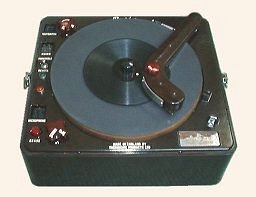| If home video recording was a revolution, then video disc must have been the underground resistance movement. Before DVD arrived, many people didn't realise that video disc even existed, and the road to the limited commercial success that disc did manage was long and rocky -- despite the predictions and expectations which had been almost universal during the First Videocassette Revolution of 1970/71. |
For as we saw in room 2, the pundits of the sixties and seventies agreed that discs would be THE mass-market video product: cheap, simple and popular, the television equivalent of the (then) ubiquitous vinyl record.
And, since the machines would only be players, not recorders, there were many different technologies which could be used; mechanical, magnetic, capacitive and optical formats were all developed, at least as prototoypes. Mechanical and capacitive formats had some limited impact, but in the end the only truly successful system was the optical / laser approach.
An early VHD prototype |  |
Although LaserDisc did become an established format, it took three attempts to launch it, in different forms, before it caught on. The original all-analogue LaserVision was superceded in 1988 by the gold CD-Video, which added digital sound but bombed spectacularly. The format was re-launched as LaserDisc in 1991 and finally has some success, at least amongst film buffs. But for every LaserDisc player sold there were 85 VCRs, so it was never a major player -- and then DVD arrived and took away even this niche market.
But the original appeal of disc, as a cheap mass-market medium for pre-recorded programs, never materialised -- LD being very much a premium format, with discs retailing for £25-£50 [£30-£60 today]. The main reason for this, apart from the over-optimistic predictions of market share and low-cost disc production, was the unexpected explosion of cheap sell-through tapes. Even bulk-pressed discs can't compete with a £9.99 price tag for a feature film.
In this wing of the museum we will follow the history of the development of video disc through the very few formats which did actually make it onto the market. Each room in the wing covers a different fundamental technology - mechanical, optical and capacitive. |
| Magnetic Disc - the format that never was... |
| Oddly, in a story which is dominated by magnetic tape formats, no magnetic disc system was ever launched for home use. This is surprising, because magnetic disc recording is actually a very old idea -- mainly because it is much easier to produce a magnetic disc than a tape. |
And in fact, way back in the early days of magnetic recording, before tape recorders, dictation machines were made which were effectively gramophones with the record replaced by a magnetic disc, and the stylus by a read/write head. A simple spiral groove mechanism moved the tone arm across the disc to record and replay a single track.
Broadcast quality magnetic disc systems were commonly used for instant replays: the machine records continuously, keeping the last 30 seconds or so, and can be switched from record to replay as soon as something important happens. Like most disc systems, the key feature is the instant access to any part of the recording. | 
A disc recorder, probably 1940's |


